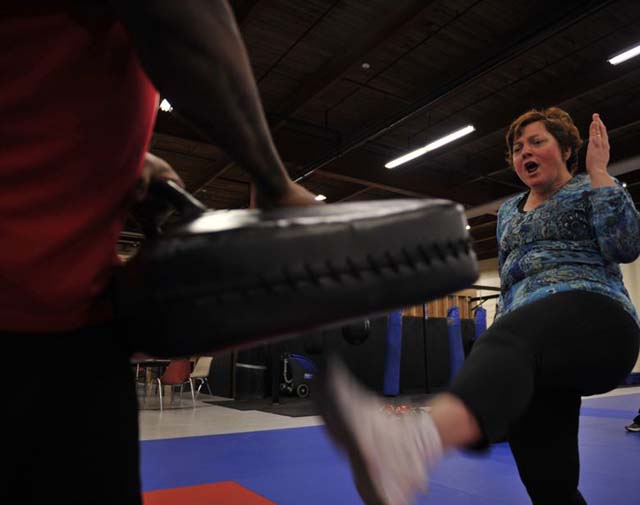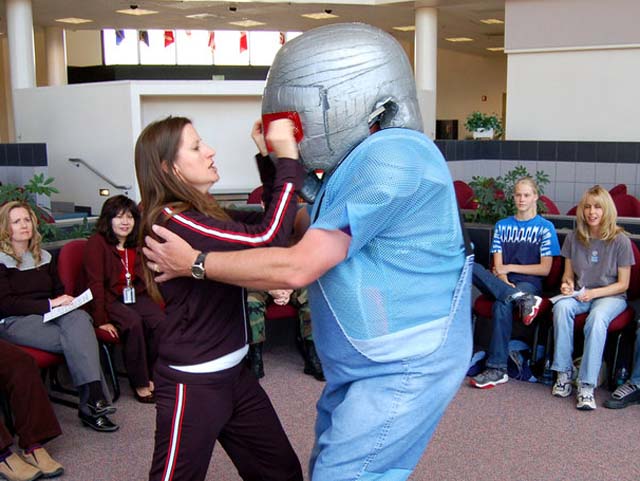Unfortunately, as a woman, I know the importance of learning self-defense. By the time I was fourteen, I’d already been sexually assaulted twice. Then, in my late 20s, I had the displeasure of having to fight off a would-be rapist by kicking and biting him.
Here, I’m going to deal with self-defense for women specifically.
[toc heading_levels= “2”]
 Disaster Preparedness For Women: 52 Steps To Get Ready For Any Emergency
Disaster Preparedness For Women: 52 Steps To Get Ready For Any Emergency
The Most Sensible Disaster Prepping Book You’ll Ever Read?
In Disaster Preparedness for Women, Diane Vuković takes a refreshingly level-headed approach to prepping specifically geared towards women. Available in paperback or on Kindle
Should Women Fight Back if Attacked?
In many situations – like getting mugged – the best solution is NOT to fight back. Fighting back just increases your likelihood of getting injured or killed. Instead, throw your wallet near the mugger and run away. The mugger will have gotten what he wants and won’t follow you.
Of course, there are exceptions. When the attack is violent, you should fight back to protect yourself. Likewise, studies show that drawing a firearm prevented injury and property loss to the victim. Every situation is unique, but you should fight back with everything you have if you feel at risk of bodily harm.
But what about in situations of rape?
There have been several studies on whether fighting back reduces the risk of being raped. These studies found that when women fight back, their odds of being raped are cut in half.
These studies also show that women who fight back are more likely to be injured. Some people might interpret this as meaning women shouldn’t fight back to avoid injury. However, the evidence shows that women fight back because they are being injured – not that they are injured because they fight back. Fighting back does not increase the risk of additional injury.
The Problem with Most Self-Defense for Women
As Carolie Cunning writes in the Washingtonian,
“Traditional self-defense tends to fall into one of two categories. The first is learning how to fight. The second is learning a list of rules that women are told to follow, most of which start with ‘never’: Never go out alone at night. Never drink at parties. Never wear revealing clothing. Never talk to strangers.”
Unfortunately, neither of these approaches necessarily helps keep women safe.
Never Walk Alone at Night…
On a surface level, most of us have moved past victim-blaming. We know that getting drunk or wearing a short skirt doesn’t mean a woman was “asking for it.”
Yet, women are still constantly told, “Don’t walk home alone,” “Don’t get drunk,” and other advice meant to keep them safe. This is just another way to blame women for their assaults: If a woman was doing something “risky” when she was assaulted, she should have “known better,” and therefore, it must be her fault.
Need examples? How about…
- The judge who suggested that a rape victim was to blame for her attack because she was drunk…
- The judge who asked an assault victim why “she couldn’t keep her knees together.”
- When the Canadian politician John Cummins implied that murdered women were to blame because they “put themselves at risk.”
I even went to one Krav Maga course where the instructor suggested that we all cut our hair short so it would be harder for an attacker to grab us!
As a feminist, I have a significant issue with this safety advice for women: It burdens the woman.
Jessica Eaton makes a good point about this unfair burden on women:
In the aftermath of a terrorist attack, public officials say “we will not change our way of life… we will carry on as normal because we deserve a safe society.”
Yet, when predators are on the loose, women are warned to change their behaviors and take caution lest they be victimized.
Should You Change Your Behavior to “Play It Safe”?
Let’s be clear: It’s not a woman’s job not to be raped. It’s a man’s job not to rape.
But I also know the world we live in. Like how I use a home security system against burglars, isn’t it reasonable to take precautions like not walking home alone at night?
Yes… And no.
It’s one thing to listen to your gut instinct and escape dangerous situations. It’s another thing altogether to avoid activities out of paranoia and fear.
As I discussed in my post about why I’m not afraid of getting raped, rape is NOT a crime of passion or lust. Rape is about taking control away from a woman.
With every warning to “be cautious,” you are taking away my choices and power in the same way that a rapist does.
Ironically, most rapes don’t even occur when walking alone at night. They occur indoors and usually by people we know. So, all that paranoia and fear is usually for nothing.
Keep that in mind the next time someone suggests that an activity isn’t “safe” for you to do.
When the Attacker is Someone You Know
The first “self-defense” for women is telling them not to do risky activities. The second method is teaching them how to kick butt, such as teaching women cool moves like groin kicks and eye jabs. These are great to know (and we’ll talk about some of the best moves later in this post).
But knowing how to kick butt doesn’t necessarily make a woman safer. Why? Because the sad reality is that in 80% of sexual assaults, the woman knew her attacker.
It’s a lot harder to groin-kick someone when the attacker is your Uncle Henry, and the little voice in your head says that, “This must be a mistake,” because imagine how awkward Thanksgiving dinners will be after you tell Aunt Matha.
Case in point: Consider how many sexual assaults occur in the military.
If learning badass self-defense moves was effective, we would see fewer incidences of sexual assault in the military. Yet, the rate of sexual assault is just as high.
Defense attorneys even try to use their knowledge of self-defense against female soldiers who have been victims of assault: They routinely tell juries that soldiers could not have been raped because they’ve had self-defense training.
This doesn’t account for the fact that soldiers are trained to use self-defense tactics in combat situations, not against their colleagues.
Again, it’s much harder to jab someone in the eyes when it’s someone you know and thought you could trust.
Women: Stop Being Polite!
One of the big problems in our culture is that women are trained to be “polite” and prioritize other people’s emotions over their own. Ask a woman to do something that makes me uncomfortable or is a hassle. Women are likelier to say yes to avoid conflict or hurting someone’s feelings.
It’s no wonder that so many women were worried about “hurting his feelings” in the uncomfortable moments that led up to a sexual assault from an acquaintance.
As one high school student said about her sexual harassment experience,
“I told him to stop every time he did it, but I said it this way, ‘Oh my gosh, stopppppp!’ with my voice highly pitched and with a playful shove. I didn’t want to hurt his feelings by acting too sensitive to the situation.
Because of this ingrained feeling that we need to be polite, a considerable part of self-defense for women is learning to set boundaries. It overrides all those lessons about politeness, so we speak up when someone takes advantage of us.
Because of this, I think that ESD is the best self-defense training course for women.
ESD: The Best Self-Defense Training for Women

Also called “feminist self-defense,” ESD stands for Empowerment Self Defense. It takes a much more holistic and realistic approach to self-defense than your standard “kick ’em in the groin” class (though they teach you to do groin kicks, too!).
Instead of just teaching you to defend against strangers jumping out at you in dark alleys, ESD addresses the fact that most assaults occur from people we know. It focuses on setting boundaries and de-escalation tactics so assaults can be prevented in the first place.
And, when those tactics don’t work, the training also teaches physical self-defense.
Learning to Set Boundaries
For example, in empowerment-based self-defense training, students might do simulations where a coworker is trying to dump a load of work on you. Your job is to tell the coworker “No.”
If you can’t speak up for yourself in harmless situations like that, how are you supposed to say no to the jerk putting his arm around you or the drunk guy in the bar getting way too close…?
I can’t emphasize how important this is. Most violence starts with boundary testing in a way that feels uncomfortable but isn’t an attack.
For example, a man might sit beside you on the bus even when all the other seats are empty. If you don’t immediately tell him to sit somewhere else, he might take it as an invitation to comment on your appearance. If you still fail to set boundaries, then it might escalate into him following you home…
Some examples of how you could establish boundaries:
- A man grabs your arm to stop you from leaving a bar. You look him in the eyes and calmly say, “I will be leaving now. Let go of me.”
- A colleague starts rubbing your shoulders. You tell him, “I don’t like that. Please stop.”
- A date insists forces himself on you. Say, “Get off of me. This is rape.”
- A man is walking behind you in a secluded street. You aren’t sure whether he is a threat or just going the same direction as you. Cross the street to increase the physical distance. If he also crosses the street, ready your weapon and scream.
The research backs this up. Women who learned to set boundaries were drastically less likely to be raped and were more likely to identify threatening situations. Understanding verbal and confidence skills seems more effective than learning physical skills (though knowing how to do a groin kick is essential, too).
As a parent, I feel it’s essential to start teaching boundary-setting early on. My dad’s friend molested me when I was 8 years old. I knew something “wasn’t right” but didn’t say anything because I was supposed to be polite to adults. Stranger Danger doesn’t address that assault is likely to come from someone they know and trust. You must teach children that they don’t have to be polite to adults who make them uncomfortable. Whether it’s grandma pinching their cheek or a counselor telling them to sit on his lap, they have the right to say no.
De-escalation Tactics
Empowerment Self Defense also teaches de-escalation techniques, or “verbal self-defense.” These tactics aren’t as practical against sexual assault or attacks where the perpetrator’s sole intent is to harm. However, in situations where someone ordinarily peaceful snaps, you could use these tactics to talk yourself out of harm.
The goal of de-escalation is to diffuse anger before it becomes explosive. It involves much more than telling an attacker to “calm down.”
The human brain works on three levels:
- The reasoning brain that can understand complex issues,
- The rational “mammalian” brain
- The “reptilian” brain controls our fight or flight instinct.
When a person becomes emotional, their brain stops being reasonable and rational. Instead, the reptilian brain takes over. They are desperate to feel in control. Anything you do to make them feel threatened, such as shouting or drawing a weapon, will make them more aggressive. Even saying “calm down” will likely backfire because they will feel like you are taking control of the situation away from them.
The first step of de-escalation is to assess what emotional state the attacker is in. You can do this by asking open-ended questions like, “How can we solve this?”
If the person can respond, you know their reasoning brain is still functioning. If they are muttering things like, “How could you?” then you know they are in fight-or-flight mode. The worst-case scenario is that they don’t respond at all. They are quiet and have a blank look. This is a sign that they are about to attack, and you must get ready to fight back.
If your attacker is responsive, you can use various techniques to get him (or her – women certainly are perpetrators of crime, too!) to calm down. Some ways to do this are:
- Continue asking open-ended questions. This will force the attacker to use their reasoning brain and become less emotional.
- Use non-threatening postures and gestures. If your attacker is standing, you might choose to sit a good distance away to show you aren’t a threat.
- Slow down your speech. This will also cause the attacker to slow down his speech and thoughts. Never shout; use a low, calm tone.
- Acknowledge the attacker’s anger, such as by offering an apology. Even if the attacker is unreasonable, you should never say they are wrong or overreacting.
- Don’t stand your ground. You should enforce boundaries, but sometimes your boundaries will be irrelevant. Many people snap and go on violent sprees because of small things like an argument over whose turn it is in line. It’s better to stay safe than to try to enforce what you think is fair or right.
*ESD isn’t the only self-defense method that teaches de-escalation tactics. Many more classes are now incorporating de-escalation, especially as they realize that a more realistic approach to self-defense is needed.
Other Self-Defense Training for Women
Unfortunately, empowerment-based Self Defense classes aren’t available everywhere. And, compared to some other self-defense training, they don’t offer as much of a physical approach. If you want to learn to kick ass, then you might want to take additional training too.
Note: Besides learning cool self-defense moves, I’ve found that self-defense training can be incredibly empowering. I’ve also met a lot of great women at classes. It’s great to be in a supportive environment with other women.
Krav Maga
Krav Maga was developed for Israeli soldiers. It’s all about simple techniques that deliver the most effective results.
I still like ESD better, especially since none of the Krav Maga instructors I had ever mentioned acquaintance rape. They also constantly harped on things like how strangers were going to jump out of dark alleys and drag us away, so we had to “immediately start fighting back.”
I’m not sure that’s good advice, especially considering that it’s more likely you will be mugged than kidnapped if someone jumps out at you in an alley – and it’s usually better not to fight back against a mugger.
Despite the flaws, I still really like Krav Maga training because:
- Quick and dirty tactics: This isn’t about learning pretty moves for competition. It’s about delivering RESULTS.
- Simulated attacks: With a good trainer, you’ll simulate attacks. For example, we would perform certain moves in the dark in classes as though we’d woken up to find an attacker straddling us.
- Very physical: You will get a complete workout from Krav Maga. It’s great if you want to get in shape while also learning self-defense.
- Focus on getting to safety: This isn’t about learning to kick ass. The point of every move is so you can run away to safety. Drills reinforce the instinct to run ASAP.
- De-escalation tactics: Depending on the instructor, you may learn a lot of de-escalation tactics to prevent assaults in the first place.
Brazilian Jiu-Jitsu
Jui-Jitsu originated as a style of street fighting in feudal Japan. The Brazilian style of Jiu-Jitsu is trendy right now for self-defense, mainly because it focuses on learning to defend yourself from larger opponents.
Note, however, that there is a big difference between sport BJJ and “street” BJJ. BJJ has many rules to follow, and they don’t often translate into real-life scenarios where you’d have to defend yourself. You also wouldn’t want to spend all that time grappling on the ground when your real goal should be to run to safety.
Still, there are a lot of useful fighting skills you can learn from BJJ. If your goal is self-defense, find an instructor who focuses on those techniques, not competition tactics.
What about Martial Arts for Self-Defense?
Martial arts is an ART. It is an unsuitable self-defense class for women (or men). Why?
The main issue with martial arts is their focus on highly choreographed moves. These moves look great but aren’t useful in real-life attack situations. You will never learn the “dirty” methods like groin kicks in martial arts. These dirty methods get results, especially when dealing with larger attackers.
Another issue is that martial arts rarely discusses the situations leading up to an attack. You won’t get any training on situational awareness, de-escalation, or other prevention tactics.
However, I fully support anyone’s decision to pursue martial arts. While it might not be practical for self-defense, it can do wonders to improve your self-confidence. That, in turn, can prevent you from becoming a victim in the first place.
Best Self-Defense Moves

For self-defense moves to work (especially against a bigger, well-prepared attacker), they must be easy to use and strike sensitive areas.
The point of these moves isn’t to kick your assailant’s a$$. No matter how much you’d love to give the guy a good whooping, the entire point of these moves is to stun or injure your attacker enough so you can run away.
Below are some of the best self-defense moves and videos showing how to do them.
If Attacked from Front:
- Knee to the groin
- Eye jabs
- Palm strike to the nose
- Kick to the shin
If Attacked from Behind:
If Being Choked:
If Attacker is On Top Of You:
Do These Moves Really Work?
Plenty of articles and videos list the best self-defense moves for women. On the flip side, you’ll also find plenty of naysayers with videos showing how ineffective these moves are.
Yes, these moves DO work. The attacker I fought off a few years ago? I did it with a well-executed knee to the balls while simultaneously biting him. Then I ran away from there quickly!
But, on the flip side, an attacker who has carefully planned the attack – and chosen his victim carefully – might not allow you to fight back.
So, while the moves might not be effective in every scenario, they are still worth learning. They literally could save your life.
Read Matt’s great post on self-defense methods, including the most effective moves, the best target spots, and what works.
Choosing a Self-Defense Course
Self-defense methods come in and out of style. One year, Krav Maga will be all the rage. Next will be mixed martial arts, BJJ, or combat sports.
Regardless of the style of the course, it is essential that you are getting training that will be effective in real-life situations.
Here are some parameters to consider when choosing a course.
- Teaches De-escalation Tactics: This refers to techniques used to escape potentially dangerous situations.
- Simulates Real-Life Scenarios: Is the training all about learning moves? Or do you go outdoors in your regular clothes to endure “attacks”? It is VERY useful to be able to actually kick a guy in the groin while he wears one of those padded suits!
- Versatile: Is the entire course about one style or type of move, or will you cover various tactics such as strikes, grappling, chokeholds, etc?
- Focuses on Escape: The course shouldn’t be about kicking ass. All methods should be taught so you can run away as quickly as possible.
- Positive Environment: Simulating attacks can put your mind on edge. The environment should be comfortable, positive, and friendly to counter the dark reality of why you are learning these skills.
- Repetitiveness: Moves should be made repeatedly until they are ingrained in your muscle memory. Weekend self-defense courses can give you a good foundation, but you’ll need to invest more time to use these tactics on auto-pilot.
- Incorporates Weapons Training: No self-defense training is complete if it doesn’t train you to use pepper spray or weapons of opportunity like rocks.
REMEMBER: The only objective of self-defense is to get to safety. Your job isn’t to kick ass or subdue an attacker. It is to get away with as little harm as possible. Any course that doesn’t emphasize this isn’t teaching you self-defense.
https://rapecrisis.org.uk/get-informed/statistics-sexual-violence/
https://www150.statcan.gc.ca/n1/pub/85-002-x/2018001/article/54979-eng.htm
https://en.wikipedia.org/wiki/Rape_in_the_United_States#Statistics_and_data
https://qz.com/work/1299969/empowerment-self-defense-classes-teach-girls-how-to-set-boundaries-and-say-no/
https://www.seattlemet.com/health-and-wellness/2018/02/self-defense-classes-work-where-do-they-fit-in-the-age-of-metoo
https://www.pbs.org/kued/nosafeplace/studyg/rape.html
https://www.ojp.gov/pdffiles1/nij/grants/211201.pdf



This is great advice Diane, and was fun to read.
I just started getting into self-defense very recently. The thing about your article that really resonated with me was the whole notion that it can be ’empowering’. I’ve been lucky that I haven’t been a victim of assault myself, but I started to get interested in this because I actually saw another woman very successfully defending herself against a man. It was a really interesting experience that started out somewhat terrifying but then when she managed to beat him, I felt like it was some kind of powerful feminist moment that I found weirdly inspiring.
The one thing I do wonder about is what martial art is best if you want that kind of sense of empowerment from it? I wish I’d been able to ask this woman what her particular background was, because she did look like she had some training. All I knew was that it involved a lot of kicks, Lol.
Thanks indeed!
But, I’m curious about this: do you have tips for those who aren’t able to run away from an attacker?
(Because of reduced mobility, a sprained ankle or even just unadapted footwear!)
I know that for people from the disabled community it is extra important to be alert and assertive about our boundaries, because we are often seen as weak and thus “easy prey”. I have a good loud scream and I know a few pain inducing tricks using a wheelchair, a prosthetic limb or a walking aid, but how to actually hold off a person who has crossed the line into violence until help gets there? Or until we can (at our own slower pace) move out of the danger zone?
Thank you!
I hear you! This is why I am such an advocate of Empowerment Self Defense, which basically teaches you to set boundaries immediately so you don’t become easy prey. Most attacks are not from strangers lurking in the dark who jump out at women. The attacks are from men who slowly cross your boundaries.
When random attacks do happen, they are usually muggings or other theft crimes of opportunity. For these situations (I travel a LOT in countries which many people would consider not safe), I have tactics like having a decoy wallet and phone.
Sadly, there isn’t much we can do to stop a violent attack when the attacker is stronger than us. The best thing is to stay mentally strong so you can make smart decisions — like seeing opportunities to escape or waiting for the right moment to deliver a groin kick.
Thank you so much for this information! The part about learning boundaries is really helpful 🙂